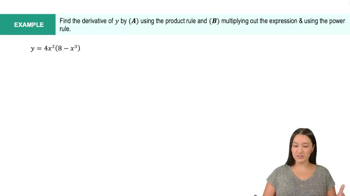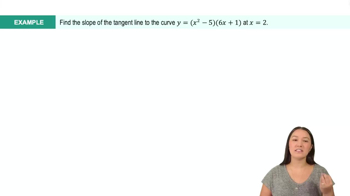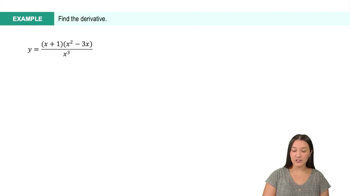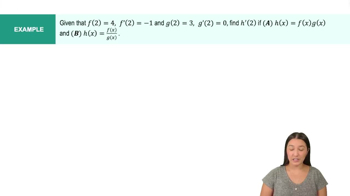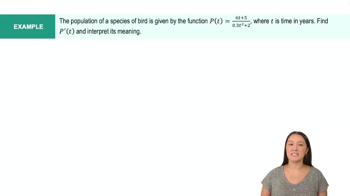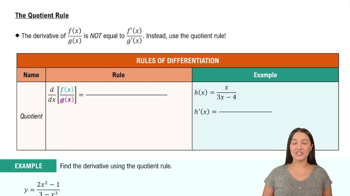Table of contents
- 0. Functions7h 52m
- Introduction to Functions16m
- Piecewise Functions10m
- Properties of Functions9m
- Common Functions1h 8m
- Transformations5m
- Combining Functions27m
- Exponent rules32m
- Exponential Functions28m
- Logarithmic Functions24m
- Properties of Logarithms34m
- Exponential & Logarithmic Equations35m
- Introduction to Trigonometric Functions38m
- Graphs of Trigonometric Functions44m
- Trigonometric Identities47m
- Inverse Trigonometric Functions48m
- 1. Limits and Continuity2h 2m
- 2. Intro to Derivatives1h 33m
- 3. Techniques of Differentiation3h 18m
- 4. Applications of Derivatives2h 38m
- 5. Graphical Applications of Derivatives6h 2m
- 6. Derivatives of Inverse, Exponential, & Logarithmic Functions2h 37m
- 7. Antiderivatives & Indefinite Integrals1h 26m
- 8. Definite Integrals4h 44m
- 9. Graphical Applications of Integrals2h 27m
- 10. Physics Applications of Integrals 2h 22m
3. Techniques of Differentiation
Product and Quotient Rules
Problem 3.R.46
Textbook Question
9–61. Evaluate and simplify y'.
y = e^6x sin x
 Verified step by step guidance
Verified step by step guidance1
Step 1: Identify the function y = e^{6x} \sin x as a product of two functions, u(x) = e^{6x} and v(x) = \sin x.
Step 2: Apply the product rule for differentiation, which states that if y = u(x)v(x), then y' = u'(x)v(x) + u(x)v'(x).
Step 3: Differentiate u(x) = e^{6x} with respect to x. Use the chain rule: u'(x) = \frac{d}{dx}[e^{6x}] = 6e^{6x}.
Step 4: Differentiate v(x) = \sin x with respect to x. The derivative is v'(x) = \cos x.
Step 5: Substitute u(x), u'(x), v(x), and v'(x) into the product rule formula: y' = 6e^{6x} \sin x + e^{6x} \cos x.
 Verified video answer for a similar problem:
Verified video answer for a similar problem:This video solution was recommended by our tutors as helpful for the problem above
Video duration:
3mPlay a video:
Was this helpful?
Key Concepts
Here are the essential concepts you must grasp in order to answer the question correctly.
Differentiation
Differentiation is the process of finding the derivative of a function, which represents the rate of change of the function with respect to its variable. In this case, we need to differentiate the function y = e^(6x) sin(x) to find y'. This involves applying rules such as the product rule and the chain rule, which are essential for handling functions that are products of other functions.
Recommended video:

Finding Differentials
Product Rule
The product rule is a formula used to differentiate products of two functions. It states that if you have two functions u(x) and v(x), the derivative of their product is given by u'v + uv'. In the context of the given function y = e^(6x) sin(x), we will apply the product rule to differentiate the exponential function and the sine function together.
Recommended video:
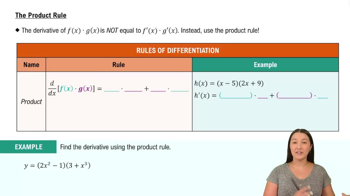
The Product Rule
Chain Rule
The chain rule is a fundamental technique in calculus for differentiating composite functions. It states that if a function y is composed of another function u, then the derivative of y with respect to x is the derivative of y with respect to u multiplied by the derivative of u with respect to x. In this problem, the chain rule will be necessary when differentiating the exponential part e^(6x), as it involves an inner function (6x) that also needs to be differentiated.
Recommended video:

Intro to the Chain Rule
Related Videos
Related Practice



